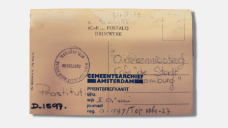A card to remember
Upon closer inspection, this picture turns out to be a postcard. This is also clear from the back, shown in figure 1. The card is part of the series Momentopnames uit het Amsterdamsche straatleven. All kinds of everyday scenes in the city were depicted on these cards, which were made by the firm Berg & Co.
The series consists of dozens of cards with different subjects (fig. 2). Such postcards were a reasonably new phenomenon at that time. They originated in the 1890s but at the time often consisted of pictures that were colored in. In the Netherlands, the entire back of the card was used to write the address. It was only after 1905 that messages were written on the cards. On our card, there is space on the back to write a message. That is why we know that this card is from later than 1905. The card also has a photograph on it, something that was not done until after 1900.
Today we mainly send postcards to each other for birthdays and other celebrations, but cards like these also used to serve as souvenirs. They painted a clear picture of the streets of Amsterdam during this time period. A tourist could choose which picture from the series reminded them of what they had seen. There is no original writing on our card, which could indicate that it was bought as a souvenir.
By studying these kinds of postcards, we learn more about street life. What was seen as characteristic? Indeed, these ladies were part of everyday street life, so much so that they ended up on this postcard and still smile at us from there.
Now let's take a closer look at the context of the card. What role did these ladies play in the Amsterdam street scene? What kind of scenes did they witness in the streets?

](https://micrio.thingsthattalk.net/IlmCj/views/max/198x128.s.jpg)